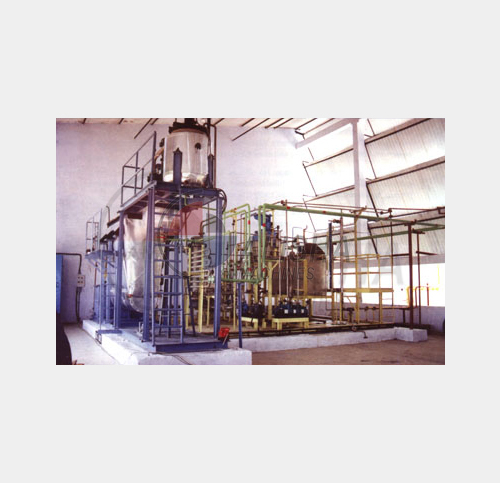Labsa Plant

SULPHONATION PLANT FOR 500 KGS/HR. 98% SULPHURIC ACID BASED LABSA PLANT
A continuous process, skid-mounted plant consisting of day tanks, storage tanks, flow control and proportioning arrangement, sulphonation with a dominant bath technology, complete with built-in heat removal and mixing arrangement. The plant also contains ageing, dilution and separation sections for stratification of the product and byproduct spent acid.
The plant is provided with appropriate instrumentation with alarms / safety interlocks to warn the operator and/or prevent any malfunction. A control panel allows remote plant operation. Local and remote display of critical parameters enable ease of operations and control.
The plant is constructed on a skid platform with built-in ladders/operating platforms for easy operational and maintenance access. The skid and plant construction allows quick at-shop assembly, disassembly and at-site re-assembly as well as easy relocation of the plant should the need arise.
Capacities available from 250 kgs/hr. to 10,000 kgs/hr.
ADVANTAGES OF SULPHURIC ACID BASED SULPHONATION PLANTS
1. Capital outlay-wise, these plants are considerably cheaper than the sulphur burning plant.
2. Sturdy, easily relocatable plants requiring little maintenance as compared to the complicated, instrumented sulphur burning plants which require round the clock maintenance with skilled personnel both for mechanical as well as instrument parts.
3. Unaffected by sudden power outage. No off-spec product generation. Sulphur burning plants are extremely intolerant of any unscheduled shutdown with generation of substantial qualities of off-spec product, and in certain circumstances, badly charred product difficult to blend.
4. Better conversion due to very low NDOM (Non-Detergent Oily Matter) and yet excellent colour of the sulphonated product (and hence, of the finished detergent)
5. Lower operating costs: Sulphur burning plants also run a mini-sulphuric acid plant in addition to the sulphonation plant. This requires substantial amount of energy to drive the main air blower, dry air generation unit etc.
6. Much milder environmental impact. The sulphuric acid based plant by-product is much sought after for making super phosphated. Thus, there is no effluent stream. On the other hand, the sulphur burning plant needs extensive treatment of the exhaust gases including scrubbing, electrostatic mist removal etc. All this not only requires electricity but also leaves several effluent streams requiring treatment.
7. Easy to operate and control with just one operator per shift as compared to the sulphur burning plants requiring several skilled personnel per shift.
